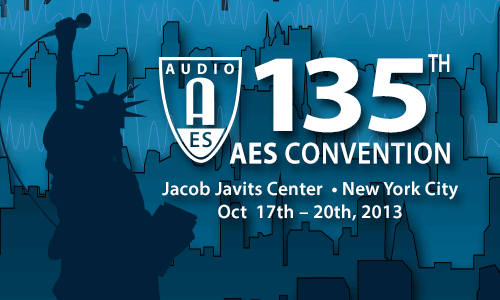AES New York 2013
Paper Session P4
P4 - Room Acoustics
Thursday, October 17, 2:30 pm — 4:30 pm (Room 1E07)
Chair:
Ben Kok, SCENA acoustic consultants - Uden, The Netherlands
P4-1 Investigating Auditory Room Size Perception with Autophonic Stimuli—Manuj Yadav, University of Sydney - Sydney, NSW, Australia; Densil A. Cabrera, University of Sydney - Sydney, NSW, Australia; Luis Miranda, University of Sydney - Sydney, NSW, Australia; William L. Martens, University of Sydney - Sydney, NSW, Australia; Doheon Lee, University of Sydney - Sydney, NSW, Australia; Ralph Collins, University of Sydney - Sydney, NSW, Australia
Although looking at a room gives a visual indicator of its “size,” auditory stimuli alone can also provide an appreciation of room size. This paper investigates such aurally perceived room size by allowing listeners to hear the sound of their own voice in real-time through two modes: natural conduction and auralization. The auralization process involved convolution of the talking-listener’s voice with an oral-binaural room impulse response (OBRIR; some from actual rooms, and others manipulated), which was output through head-worn ear-loudspeakers, and thus augmented natural conduction with simulated room reflections. This method allowed talking-listeners to rate room size without additional information about the rooms. The subjective ratings were analyzed against relevant physical acoustic measures derived from OBRIRs. The results indicate an overall strong effect of reverberation time on the room size judgments, expressed as a power function, although energy measures were also important in some cases.
Convention Paper 8934 (Purchase now)
P4-2 Digitally Steered Columns: Comparison of Different Products by Measurement and Simulation—Stefan Feistel, AFMG Technologies GmbH - Berlin, Germany; Anselm Goertz, Institut für Akustik und Audiotechnik (IFAA) - Herzogenrath, Germany
Digitally steered loudspeaker columns have become the predominant means to achieve satisfying speech intelligibility in acoustically challenging spaces. This work compares the performance of several commercially available array loudspeakers in a medium-size, reverberant church. Speech intelligibility as well as other acoustic quantities are compared on the basis of extensive measurements and computer simulations. The results show that formally different loudspeaker products provide very similar transmission quality. Also, measurement and modeling results match accurately within the uncertainty limits.
Convention Paper 8935 (Purchase now)
P4-3 A Concentric Compact Spherical Microphone and Loudspeaker Array for Acoustical Measurements—Luis Miranda, University of Sydney - Sydney, NSW, Australia; Densil A. Cabrera, University of Sydney - Sydney, NSW, Australia; Ken Stewart, University of Sydney - Sydney, NSW, Australia
Several commonly used descriptors of acoustical conditions in auditoria (ISO 3382-1) utilize omnidirectional transducers for their measurements, disregarding the directional properties of the source and the direction of arrival of reflections. This situation is further complicated when the source and the receiver are collocated as would be the case for the acoustical characterization of stages as experienced by musicians. A potential solution to this problem could be a concentric compact microphone and loudspeaker array, capable of synthesizing source and receiver spatial patterns. The construction of a concentric microphone and loudspeaker spherical array is presented in this paper. Such a transducer could be used to analyze the acoustic characteristics of stages for singers, while preserving the directional characteristics of the source, acquiring spatial information of reflections and preserving the spatial relationship between source and receiver. Finally, its theoretical response and optimal frequency range are explored.
Convention Paper 8936 (Purchase now)
P4-4 Adapting Loudspeaker Array Radiation to the Venue Using Numerical Optimization of FIR Filters—Stefan Feistel, AFMG Technologies GmbH - Berlin, Germany; Mario Sempf, AFMG Technologies GmbH - Berlin, Germany; Kilian Köhler, IBS Audio - Berlin, Germany; Holger Schmalle, AFMG Technologies GmbH - Berlin, Germany
Over the last two decades loudspeaker arrays have been employed increasingly for sound reinforcement. Their high output power and focusing ability facilitate extensive control capabilities as well as extraordinary performance. Based on acoustic simulation, numerical optimization of the array configuration, particularly of FIR filters, adds a new level of flexibility. Radiation characteristics can be established that are not available for conventionally tuned sound systems. It is shown that substantial improvements in sound field uniformity and output SPL can be achieved. Different real-world case studies are presented based on systematic measurements and simulations. Important practical implementation aspects are discussed such as the spatial resolution of driven sources, the number of FIR coefficients, and the quality of loudspeaker data.
Convention Paper 8937 (Purchase now)
